The Son Tay Raid Rescue Mission: A Pilot’s Story
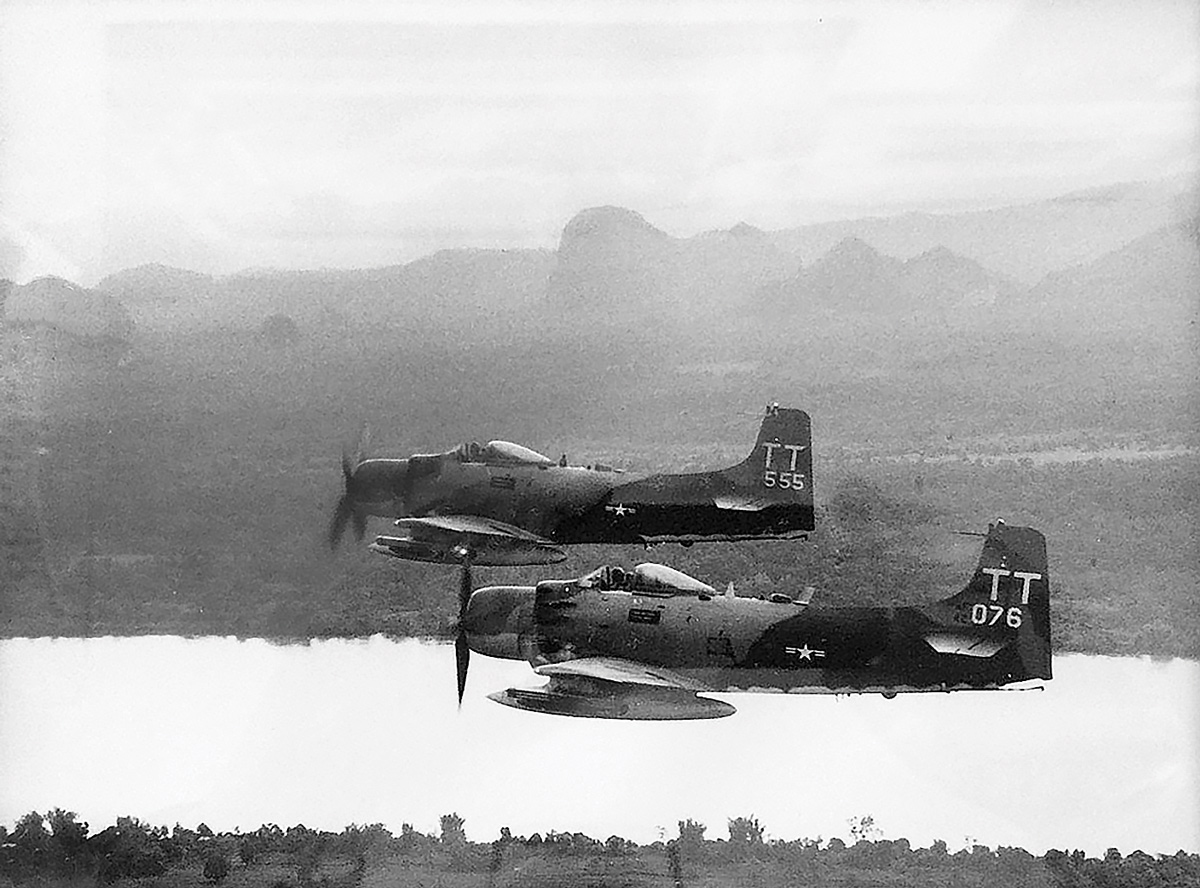
A-1 Skyraiders over Laos
By John Waresh
The following is what I remember of the A-1 participation in the Son Tay prison camp raid…
On the Saturday night of 20 November 1970 a C-130 picked us up from Takhli where we had been housed in the CIA compound since deploying from Eglin. The NKP flight line was blacked out, even the tower people had been relieved and it was empty. The C-130 landed, without anylights on it or the runway and ramp, and taxied to the ramp. It had already lowered the rear ramp and when it came to almost a stop ten of us ran out, two pilots for each of the five fat-faces we were taking. It then continued on, pulling up the ramp, taxied out and took off. It had other people to deliver to other locations. The only people out and about were the crew chiefs and us. Of course the Wing Commander met us and followed me around like a puppy dog asking question after question, none of which I could answer. He got rather teed off as I recall.
Picking up our flight gear we went straight to the birds, cranked up and taxied out. No taxi, runway or aircraft lights were used and no radio either, total silence (the radio was not to be used till over the camp).
Taking off at the exact second, we did a 360 over the base to join up. A C-130 Talon was to rendezvous with us there and lead us on. Timing was everything. It wasn’t there. We did two more 360s and couldn’t wait any longer. We were, by that time, about ten minutes behind schedule.
The backup plan was to navigate ourselves to Son Tay, following the planned route and arriving at the appointed time, 0200 local, Sunday, 21 November. No way, José. We had agreed among ourselves earlier that that was not a viable plan. We would fly the course until we got lost, which we knew we would, and then head straight for Hanoi. Hold just south of the IP, which was the Black River, straight west of the camp, and do our thing at the TOT (Time Over Target).
The route was NKP, straight to Vientiane, straight north out of there and then drop to low level and weave through the karst and valleys all the rest of the way. Impossible at night for A-1s. A back up rendezvous with the Talon was over Vientiane at the appointed minute, but, because we had made an extra 360 over NKP waiting, we were running late. We had been unable to make up all the lost time, some of it but not all. We hit Vientiane a few minutes late, maybe five, no Talon. We turned north and pressed on.
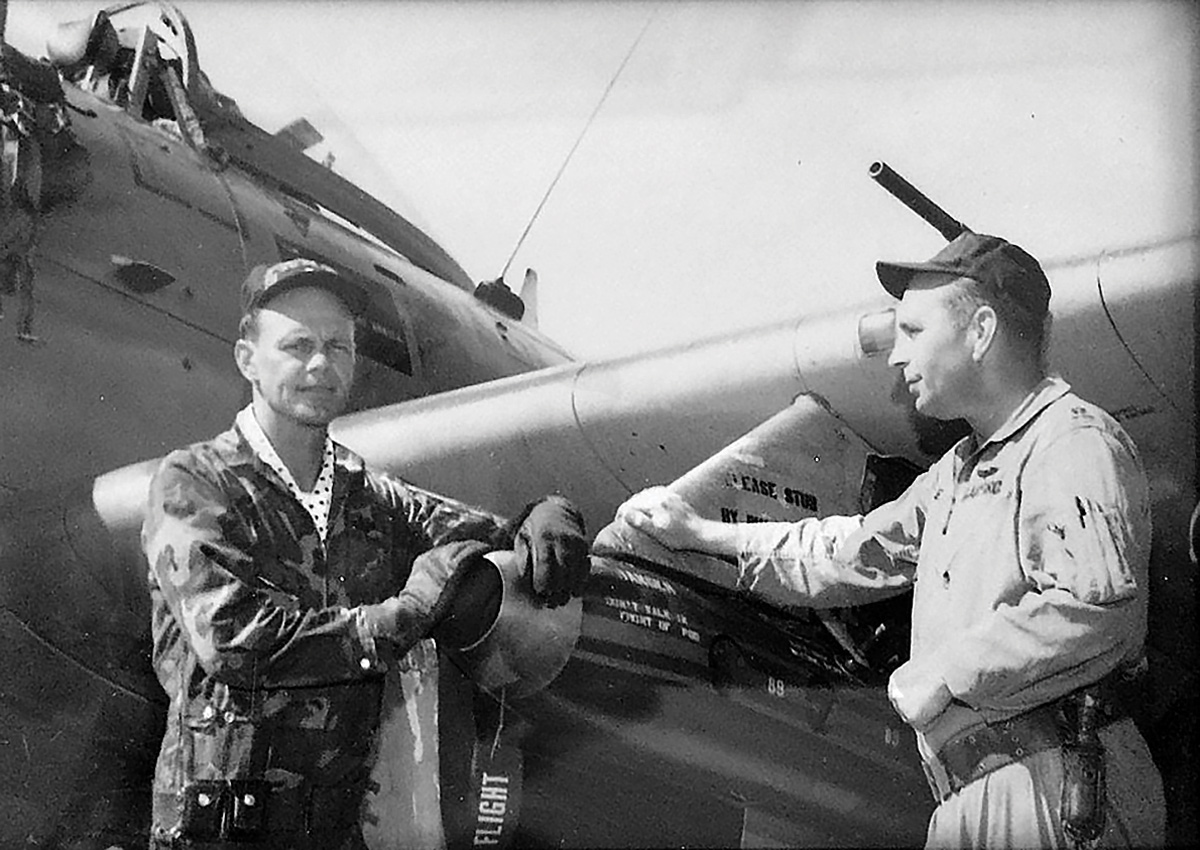
At left, John Waresh was in the 602 Special Operations Squadron, NKP, Thailand. He flew A-1 Skyraiders, all missions except two were in Laos. The other two were into North Vietnam.
After Vientiane passed behind, there were no lights anywhere, ink black. And then our worst nightmare loomed up. A cloud bank. Being lead, I wasn’t worried about being hit, but the rest of the flight exploded like a covey of quail, everyone in God only knows what direction. Pushing it up, I climbed straight ahead and soon popped out on top. Not an A-1 in sight and no hope of joining up again without lights or radio. We were all on our own.
After a short time, we noticed a speck of light far ahead. A star? After watching it a while, we were sure it was below the horizon and no Lao in his right mind would have a light on. Had to be something else. Heading straight for it, it took some time to catch. A fully loaded A-1 is no speed demon.
Sure enough, there was our Talon with a teeny-weeny white light on the top of the fuselage and a dim bluish glow coming from the open ramp in the rear. Couldn’t see the bluish glow until you were only few meters from it. There were already two A-1’s there, one on each wing. We moved up and the left one moved out and we took our place on the left wing tip. A few minutes later the other two A-1’s slowly pulled up and once we were all in place the little white light went out, the bluish glow went out and the Talon descended into the black. From there on it was hold on tight as it bobbed and weaved through the hills and valleys.
The Talon driver was top notch. His power applications during climbs and descents and gentle banking allowed our heavy A-1 to hang right in there. The three day “moon window” we had for this operation provided good night vis. With one exception—several valleys we drove through were so deep that mountains, karst, trees or whatever eclipsed the moon. When that happened it was like diving into an inkwell. You could make out only a few feet of wing tip and that was only because of our own exhaust flame. When turns or ups and downs occurred at those times it was tough.
As we emerged from the back country out over the Red River Valley it was almost like being over Iowa farm country with Omaha/Council Bluffs up ahead. (Hanoi) Lights everywhere. Soon thereafter the Talon started climbing and we knew the IP was coming up. We had a controlled altitude over the IP. The choppers, with their Talon, were going to be under us coming in from a different direction. They should have been slightly ahead of us but one couldn’t be sure everyone was on time. The control time was over the camp so IP times were adjusted for the different speeds.
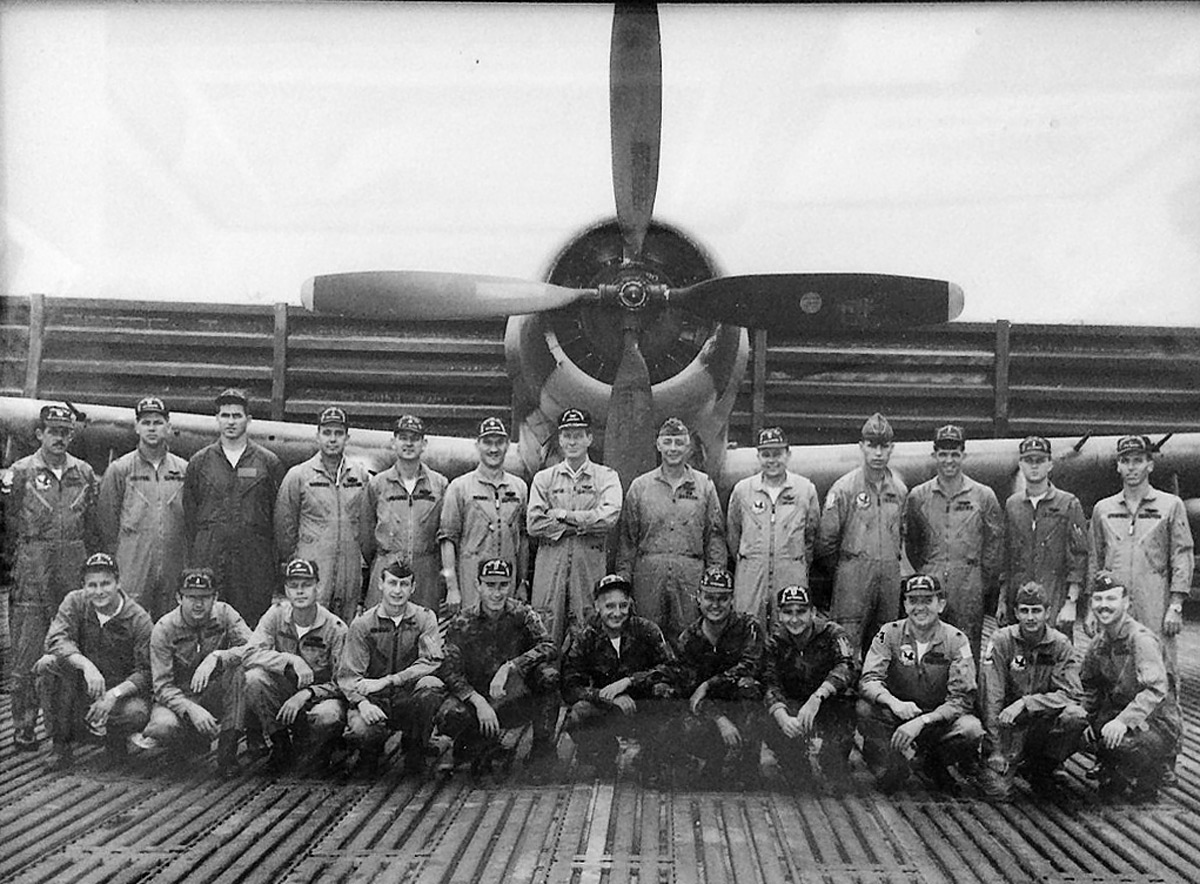
April 1970 — then Major John Waresh, first row, third from left.
Then the Talon transmitted the code word. First of anything we heard on the radio all night. I can’t remember the word but it was to be picked up by a high orbiting EC-135 over northern Laos and relayed back to wherever. It meant we had crossed the IP (we were two seconds off. The best anyone had done during practice was ten minutes. Of course we didn’t have Talons for the practice). The Talon then accelerated out and up like a shot and disappeared in the night. The heading to the camp was 091 and trying to reset our DG by a giggly whiskey compass was an effort in futility. You remember the high tech, latest hardware we had on board. Good thing all the towns, cities and roads were lit up. With the target study we had done it was like being in your own back yard.
Next number 5 pealed off to the right. He was backup in case anyone was shot down and was to orbit a large hill just south of course until called in. As it turned out the hill was an Army artillery practice range and it wasn’t long before they started taking a few rounds. They moved off to somewhere else, probably closer to the camp, don’t know where. Just another example of the brilliant intel we had.
Then 3 & 4 pealed off to the left to hold just short of the camp until called in. The plan was to call them in when we had expended 50% of our ordnance. Then they would do the same with us, each time expending 50% of what you had left. That way, if someone went down, there would always be aircraft in the air that had some ordnance left for support. Then 2 dropped back so we could set up a two aircraft daisy chain around the camp.
It was like a precision ballet, a computer simulation would not have been better timed. Just as I rolled into a bank along side the camp two flares popped right over it, having been released from one of the Talons. At the same time Banana (HH-3 with Blue Boy assault team aboard) crash landed inside the camp compound and the first Apple (CH-53) opened up with mini-guns on the watch towers and the guard quarters. The towers either blew apart or caught fire as did the guard quarters. We didn’t want the big fire consuming the two story quarters, attracting attention, but it was too late.
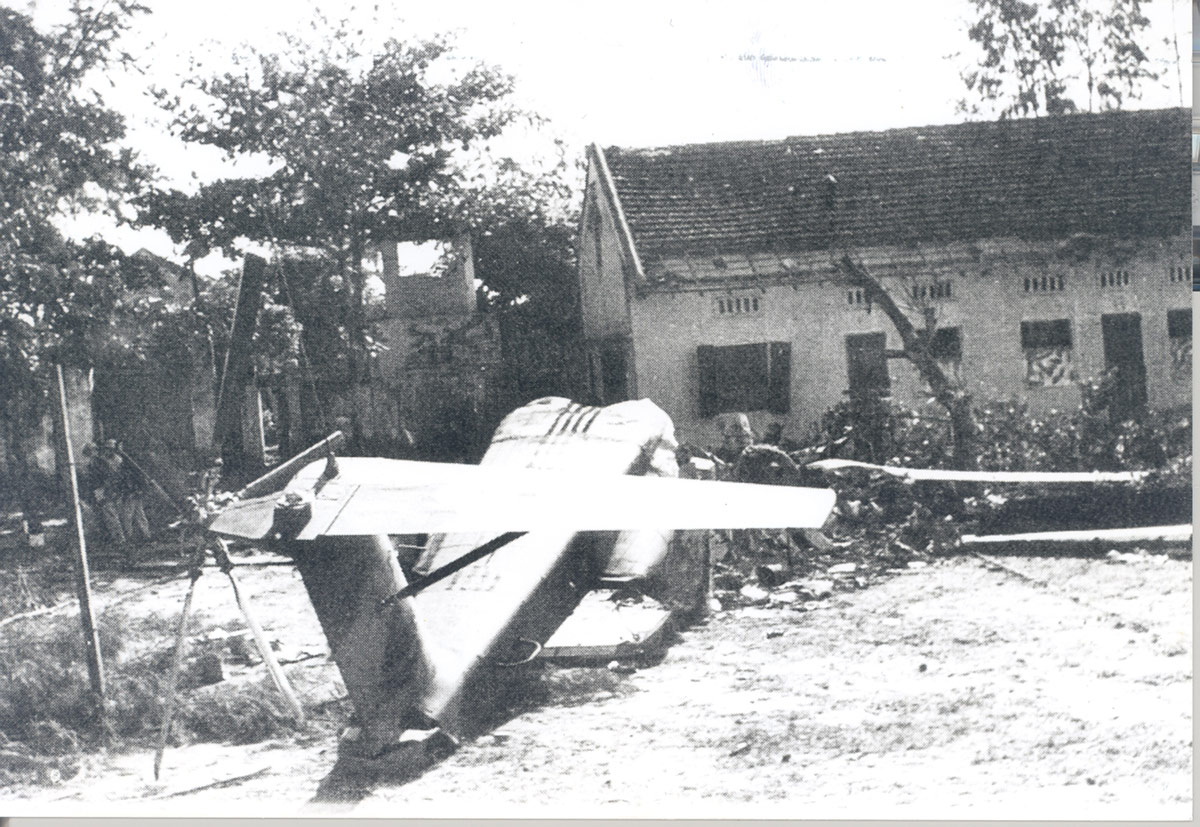
HH-3E in prison compound looking east. The guard tower is directly over the east entrance gate.
At that time we had nothing to do except to make sure no one approached the camp. No one did. We could see the sparkles from a Fire Fight Simulator dropped by one of the Talons on the other side of town as a distraction and soon a large explosion and fire where another Talon dumped napalm on an infantry base armory a few klicks to the South.
Then the shit hit the fan. Gear Box (The Command and Control team) started yelling about losing Axle. Axle was Col. (Bull) Simons personal call sign. “We’ve lost Axle” he kept yelling. “God damn, Simons has been killed, we’re all in deep shit.”
At this point I’d like to say that I think the Universe will collapse in upon itself in the Big Crunch before the Army and Air Force will ever be able to talk to each other on a radio and have each other understand what’s going on. He wasn’t lost like being dead in AF jargon, they just didn’t know where he was, couldn’t find him.
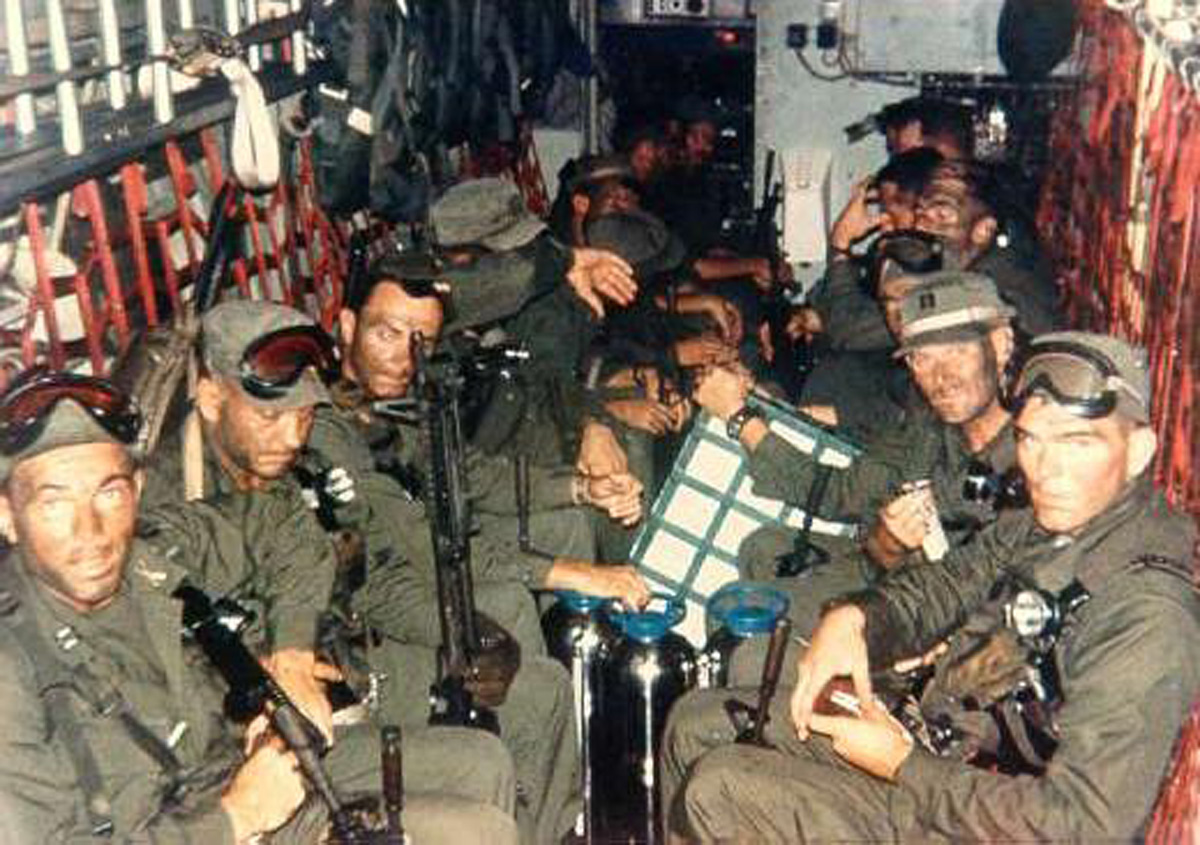
Blueboy assault group aboard HH-3E at the start of the mission.
Then the radio erupted with chatter from everywhere. The second Apple carrying half the assault force and Bull Simons, had landed the troops in the wrong place. Their heading had been one degree off coming in from the IP (whether pilot or equipment error I don’t know), placing them several hundred meters south of the camp. When the time ran out they saw a building that didn’t quite look like the guard quarters but it was the only building around, so landed. That’s where the infamous “Fire Fight at The School” took place. We called it a school because it looked like a school, regardless of what it really was. You couldn’t just keep referring to it as the white building south of the camp. There were lots of buildings south of the camp. Everything had to have a name. That way everyone knows what you’re talking about. The liberal media, though, had a small field day with that name. I remember some time later a female TV reporter asking Col. Simons if he had killed anyone at The School. He said something to the effect “I was approached by a big fella, I had a tracer as every third round in my M-16 and saw three go through his middle.” The reporter didn’t have a follow up question.
The troops in the wrong place were screaming, Gear Box was screaming and all the Apples were screaming. The FM and VHF radios were almost impossible to read let alone get anything in of your own (the UHF was kept for AF use to call the MIG Cap or Weasels if needed or to talk among ourselves) .The Apple that had dumped the guys in the wrong place was the closest so did a 180 and went in to pick them up. All the others took off and headed for the School as well just in case. No one has figured out yet why there wasn’t a midair.
The troops at the School were in a fierce fire fight the whole time they were on the ground. Right after they landed people came pouring out of the building. Most were too large in stature for Vietnamese. The guess was Chinese or Russian but no one had time to check. The estimated kill was between one and two hundred and again, no one had time to count.
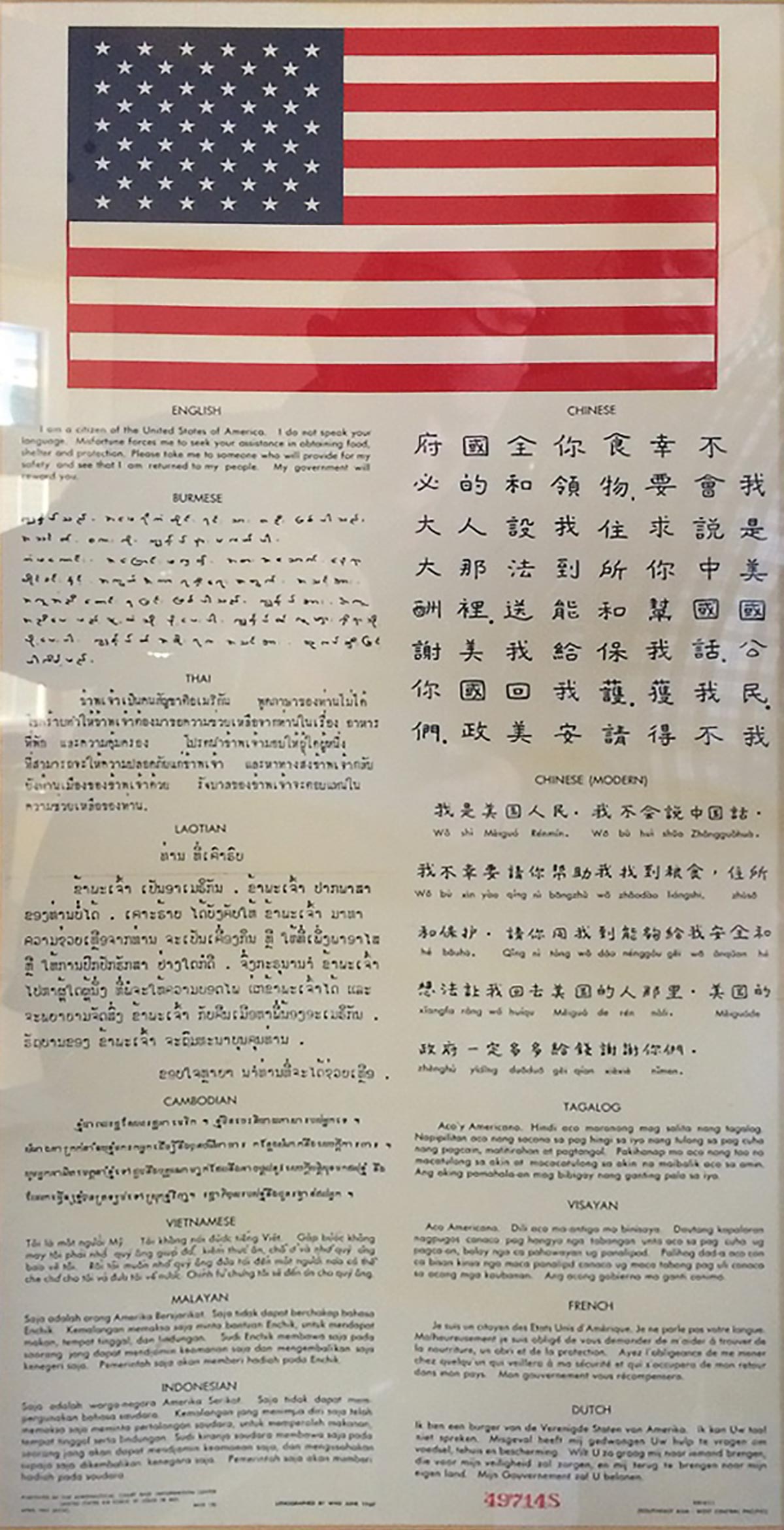
LTC John Waresh’s original chit—a silk message to be given if captured, if released they would be paid in gold.
Bull Simons and the rest of the assault force made it back to the camp without a casualty. The whole incident only lasted a few minutes but it put the entire ground operation off schedule. The two parameter teams, Red Wine and Green Leaf, headed out to do their thing but Blue Boy, the assault team inside the prison compound, had already searched most of the prison. As soon as Simons got on the radio he asked Blue Boy for a status report. The answer was “No Packages so far, still searching” (a Package was the code word for a prisoner). Simons then told us to take out the foot bridge to the Citadel.
We called a group of buildings surrounded by a small moat the Citadel. It was a few hundred meters southeast of the Camp and had a small foot bridge over the moat on the camp side. Intel told us it was a military cadet training facility and probably had a small armory for small arms. We didn’t want anyone coming across that bridge armed and get within rifle range of the camp. Jerry and I put two WP bombs on it and when 2 came in saw the bridge was wiped out and dropped short to get anyone that might have already come across. In the process taking out a few blocks of a housing area between the camp and the citadel. WP does a real number on wooden structures, the fire storm was not small.
About this time the sequence of events gets all jumbled up. I have no idea what happened first, second and so forth. About the time Simons and the troops got back to the camp the first SAM took off. You cannot miss a SAM launch at night. It’s like a mini Shuttle launch, lights up an area for miles in all directions. The first few were called “SAM, SAM, DIVE, DIVE” but that soon became silly. There were so many launches that you couldn’t call them. There seemed to be about four launch sites within a few miles of the camp on the west side of Hanoi. The rest were further east and we didn’t think they were a threat to us. Most of the SAM’s went high, after the MIG cap, Weasels and the Navy’s two-hundred plane feint coming in from the east. The idea was to make them think there was a major raid on Hanoi and not bother with a few planes on the West side. It worked. NSA told us later that the Air Defense Commander screamed “Fire at Will”, shut down the net and went off the air.
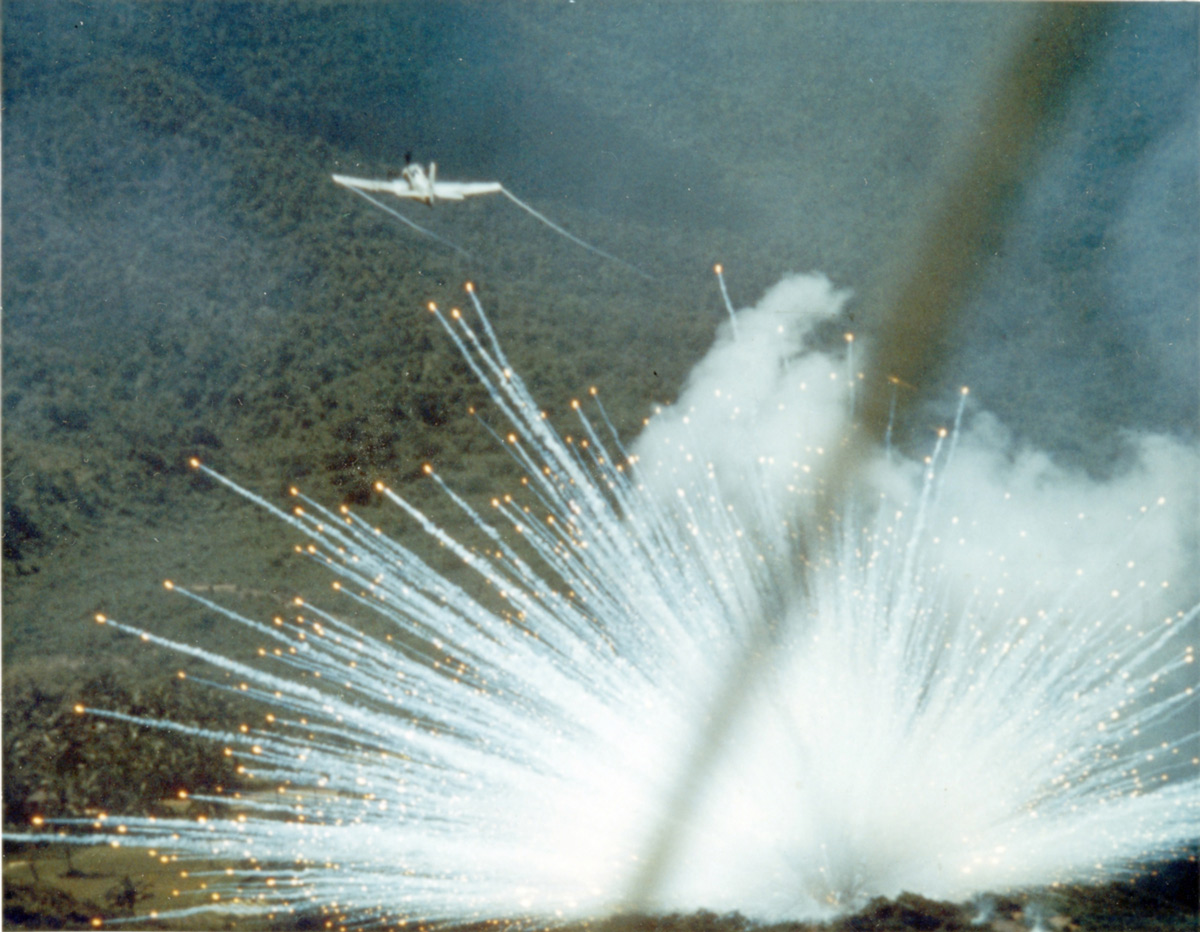
A-1E Skyraider drops a white phosphorus bomb on a Viet Cong postion in South Vietnam in 1966.
We were at our briefed 3 thousand feet until the SAM’s started coming our way. Intel told us we wouldn’t have any trouble with SAM’s at that altitude. A lot some pencil pushing puke knows. We all hit the deck and kept an eye on the launch sites close to us and sure enough, someone decided to try for the guys to the west, us. The site closest to us, just a few miles to the northeast launched one that never got to the horizon. I watched it rise and almost immediately it leveled off. Then the thing stopped moving on the windscreen. You know what that means, collision course. We dove into the Red River and turned west. Jerry was flying and I was turned around keeping an eye on the damn thing as it charged at us over my right shoulder. I kept bumping the stick forward saying “Lower, Lower.” Jerry kept bumping the stick back saying “We’re going to hit the water.” When the rocket plume on the thing seemed as big as the A-1 I yelled break left. We went up and over the river bank, about fifty feet, and leveled off at phone pole height going straight south.
We never saw the thing again. It either hadn’t had time to arm or buried itself in the water/mud so deep that the flash of detonation was masked. That’s another thing you can’t miss at night. The detonation of a SAM. It’s a lightning bright flash, quite large. They were going off over us constantly and when you got used to them you didn’t even bother to look up. For about a thirty minute period there were no less then three SAM’s airborne at any one time and other times so many you couldn’t count them. I’ve never heard an estimate of the number fired that night but it has to be in the hundreds. All the SAM misses would self-detonate, either at a pre set altitude or motor burn out; I don’t know which.
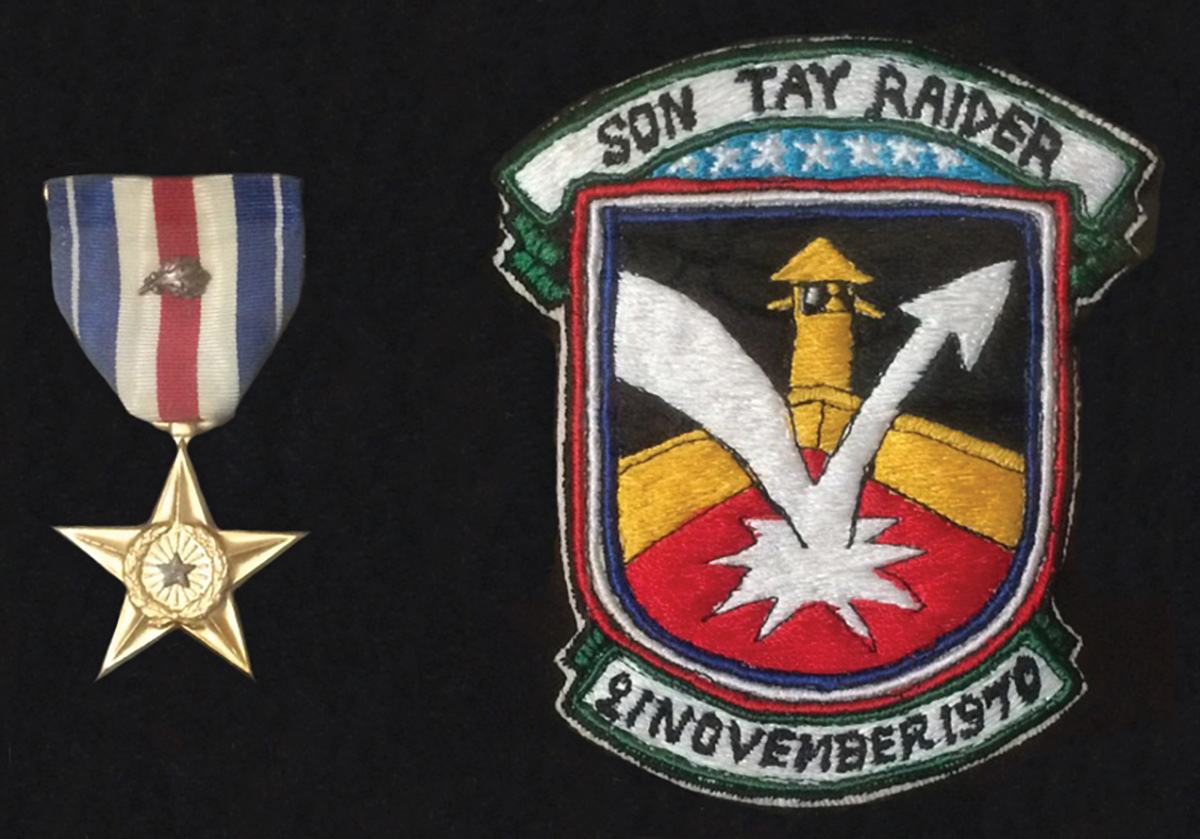
Like I said, you wouldn’t look up at a SAM detonation because they were so numerous unless something was different. Then there was something different. The flash was yellowish instead of bright white. Looking up there was a large fireball with flaming debris falling from it. “Damn, someone got nailed.” Then suddenly there was a flaming dash across the sky heading southwest, then another and another. Three dashes were all I saw, couldn’t spend any more time looking up.
Later we learned that a SAM had detonated close to a Weasel and filled his bird with holes. Fuel was streaming out and his AB was igniting it in dashes across the sky. Since he was losing all his fuel anyway he left it in AB till he ran out. He got to the southern PDJ before bailing out.
About this time Blue Boy calls Axle and says “Search complete, negative packages.” Silence, then Simons asks for a repeat. “Search complete, negative packages, repeat negative packages.” More silence.
I don’t know what anyone else was thinking then but for me it was setup, ambush. But hell, we’d already been there twenty minutes and they’d have sprung it by then. So then it turned to “What the hell are we doing here?” And “How the hell are we going to get our asses out of here intact.” Simons must have been thinking the same thing. He called for the parameter teams to pull back and the Apples to come in for pickup. Then he told us to take out the Big Bridge.
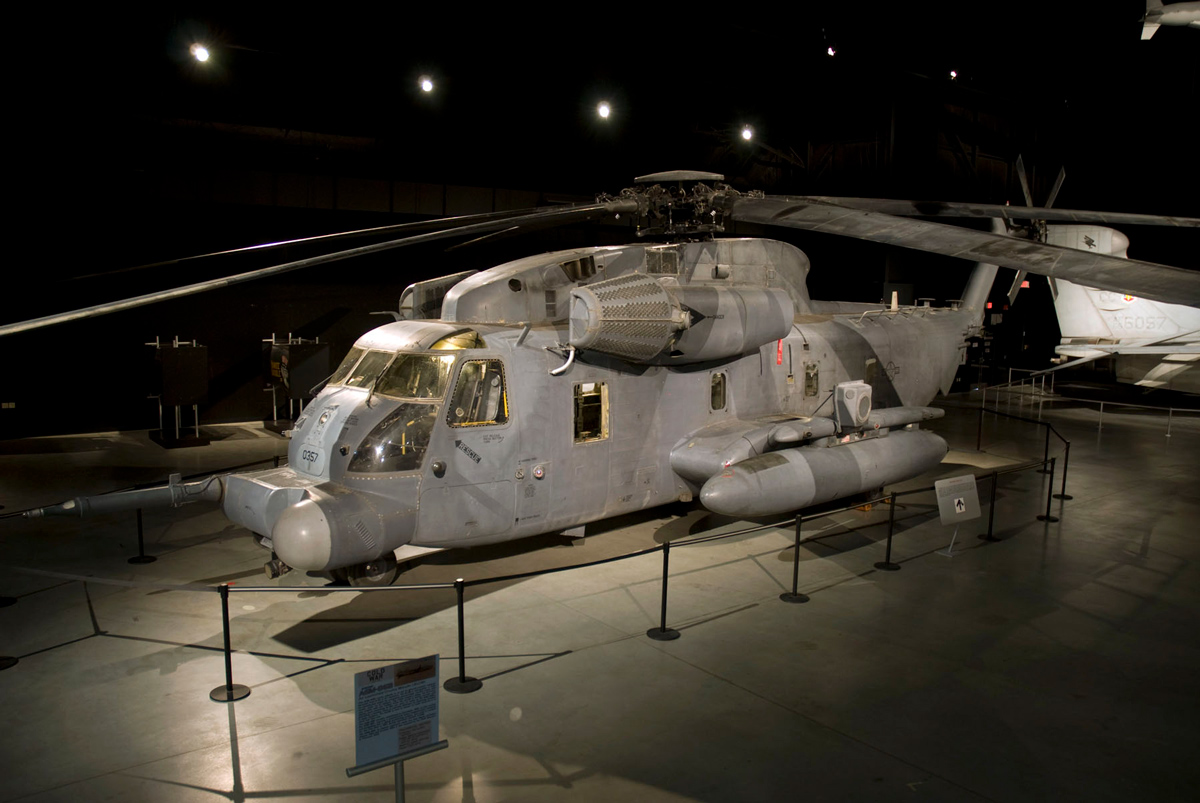
An MH-53M (serial number 68-10357) that took part in the Son Tay Raid call sign “Apple 1.”
All sounds very simple but it sure wasn’t. First of all we had no hard ordnance and couldn’t take out the Big Bridge. We had no more WP bombs and that was the only thing that would have damaged a wooden bridge. The bridge was Red Wine’s objective and they were supposed to blow it but because of their late start hadn’t reached it before the pull back order.
A little poop about the Big Bridge. The bridge was a few hundred meters northeast of the camp on the road that ran in front of it. It was about a hundred feet long, heavily constructed and could carry any vehicle up to a tank, we were told. Red Wine was supposed to blow it and hold the road while Green Leaf went south-east and held the road there.
During training, the engineers said twelve pounds of C-4 would take out the bridge. However, to be sure they were going to double it and use twenty-four pounds. Col Simons said that he wanted to be doubly sure and doubled that to forty-eight pounds then added that two people would carry forty-eight pounds each, making it ninety-six pounds of C-4. I would have liked to see what ninety-six pounds of C-4 did to that bridge but it wasn’t to be.
What made things worse was that the outbound and pull back routes for the parameter teams were different. Since each team outbound had to take out any possible threats they didn’t want to retrace their steps and possibly run into someone they missed. He would have been one pissed off gomer. There was a lot of housing just outside the camp. Intel said it was for the camp commander, married officers and maybe some camp workers. The teams outbound went house-to-house making sure no one was going to be a threat. It was a slow process so between starting out late and an early pull back they had no chance of reaching their goal.
Since they hadn’t got to the end of the outbound route there was no way they could follow the pull back route. The radios went bananas again. “There’s part of Red Wine’s team in Green Leaf’s area of responsibility and part of Green Leaf’s team in Red Wines area. Do not fire without identification.” This was repeated over and over again. So much so that the teams couldn’t get in to acknowledge. They were so out of breath that they couldn’t say but one word between two or three panting breaths. It wasn’t fun to listen to.
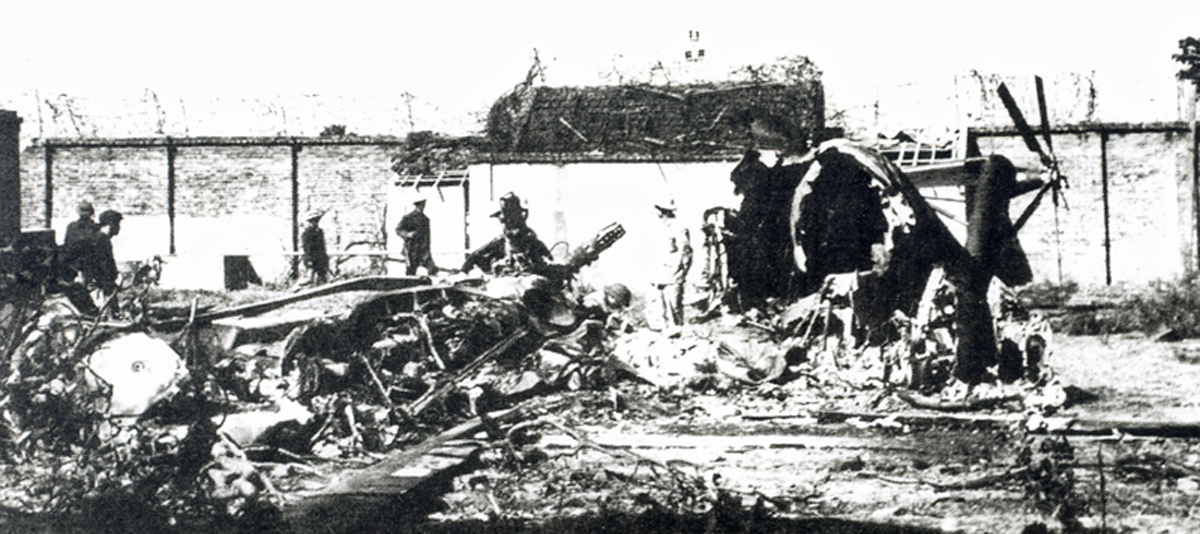
North Vietnamese photo taken inside Son Tay Prison of the HH-3E wreckage after the assault force destroyed it before leaving the area after the raid.
Some time during all this we had expended 50% of our ordnance and called in 3 and 4. They had done the same and called us back. We dumped the Rockeyes on the bridge. The Rockeye is a Navy fast mover ordnance we had to certify the A-1 to carry while in training at Eglin. It’s a multi-munitions thing with gobs of little shaped charges to take out vehicles, even tanks I guess. Not very good for bridges. We put a lot of holes in it though. After that we laid down continuous strafe till everyone was in the Apples and on their way.
I might add we never saw any vehicles or people moving anywhere near the camp. There was a lot of traffic on the east west road along the Red River, about a klick north, going in and out of Hanoi but no one turned toward the camp. Also about this time, the SAM launches were slowing down but the MIG calls were increasing. Roughly twenty minutes into the forty minutes this took we started picking up MIG calls. Intel told us they had no night-qualified pilots so we would have no trouble with MIG’s. Right!
There was one call of an air-to-air missile firing. Said it zoomed right past his plane. I don’t know who it was and never saw any myself. That was the only call of a firing I remember hearing. But the MIG warning calls from Collage Eye or whoever makes those things were coming regularly.
Once the Jollies were off and running we putted along above and behind them, guessing where they were since it was dark and no one could see each other. Everyone was to call the IP outbound. One by one we heard the calls, thank God. Then we hear this voice “Is everybody out?” “Who are you?” “This is Apple something or other.” “Where are you?” “I’m back at the holding point waiting to be sure everyone got out okay.” “God damn jerk.” We told him to get his ass airborne and head for the IP as fast as his funny machine would take him. He acknowledged.
By this time we had nearly reached the IP ourselves. Jerry and I looked at each other and said “We don’t have a choice.” With possible MIG’s around a lonely Jolly all by himself makes for a pretty good target. We turned around, climbed to a nice MIG target altitude, three or four thousand, and went Christmas tree. Every light we had was turned on and we slowly drove back to Hanoi. With MIG calls coming every few minutes I was sweating profusely. Don’t know if it was hot, I was scared or just pooped out but I was soaked. It seemed an eternity but as the camp and the West side of Hanoi was slipping under the nose we heard the IP call. Lights out and Split-S. We beat feet west for the IP on the deck.
Getting away from the river valley and into the dark countryside we climbed to a safe altitude to clear the mountains en route to Udorn. Then started to take care of some pilot stuff. We had used up the left stub tank getting there and most of the right. We were on internal over the target and used the centerline while holding. Time to clean up the fuel mess. The right stub ran out almost right away, just a couple minutes were left in it. Time to jettison. That’s when the longest two seconds of my life occurred.
I hit the button but instead of falling away it pitched up, slammed back against the leading edge making it into a vee shape and came bouncing along the leading edge of the wing toward the fuselage. I can see it to this day, making four bounces and then falling away under the wing. It all happened in one or two seconds, didn’t even have time to say “Oh shit.” I sometimes wonder what would have happened to the right horizontal stabilizer if it had decided to pass up and over the wing instead of under. I don’t dwell on it though, too scary.
The five Jollies, three carrying the assault force and two empty because of no prisoners, were all together having had to hit a tanker in order to make it back. The A-1’s were spread out who knew where but still in radio contact. As we crossed the PDJ we picked up the beeper of the downed Weasels and soon made voice contact. They were both all right. #1 was cool but #2 was a little panicky. Not because he was being threatened but because he was all alone, in the dark, in the woods, in Laos. I didn’t blame him one bit.
Then we made contact with four Sandy’s launched out of NKP in answer to the Weasel’s May Day. They didn’t know who we were because of the call signs. Took a hell of a while to convince them that Peach and Apple really meant Sandy and Jolly.
The call sign battle had been long and arduous but in the end we lost. I’ll never forgive the Air Force for either picking them or allowing them to be forced on us. At least the Army had call signs that if not macho were at least neutral. Blue Boy, Red Wine, Green Leaf, Gear Box and Axle. What did the wimpy Air Force come up with? A-1’s, Peach; Jollies, Apple, the HH-3 that crash-landed in the compound, Banana; Talons, Cherry; and the C-130 tanker, Lime. A damn fruit salad. It was embarrassing, down right humiliating. I’ll never forgive those pencil-pushing Air Force pukes for that.
Anyway, it was decided that the two empty Jollies would hang around with the four Sandy’s and make a first light pick up. From what I understand it was uncontested and pretty much a piece of cake.
Landing at Udorn we were all rushed to debriefing, a building right on the flight line. As I walked in I was met by a group of Intel people with wide grins across their faces and seemed higher then kites. I thought they were lunatics. They asked “How many prisoners?” I said, “None, the camp was empty.” The grins disappeared and their faces turned pale. “What?” I repeated it and thought they were going to pass out.
What had happened was after leaving the target area the Army did a head count and got it all screwed up. For a while they thought someone might have been left behind. For several minutes over the radio we could hear the chatter between the Jollies. “I’ve got thirty-three, I’ve got thirty-five, I’ve got thirty-two, I’ve got thirty-one.” Seemed to go on forever. Finally they got it right and no one was left behind. The high orbiting EC-135 must have been relaying all that back to Udorn and it was interpreted by the Intel people as a prisoner count. They all thought we had rescued thirty some prisoners.
Once that got squared away debriefing fell apart. People running every which way. I don’t remember ever being debriefed and don’t think anyone ever was. What preparations had been made to receive prisoners I don’t know but they had to be considerable and now were all down the tubes. It was almost a state of panic.
Col Simons, Jerry Rhine, Dick Meadows and maybe others were whisked off to meet with Gen. Leroy Manor at Monkey Mountain, Da Nang. The rest of us were left in the lurch and forgotten about. The sun was coming up by then and we all wandered out onto the ramp. We sat down on the cement cross legged, in circles of about ten, in our reeking sweat-soaked flight suits, and the grunts with their blackened faces, guns, grenades and what-have-you hanging off them. They were bleeding from every square inch of exposed skin from dozens of cuts, scrapes and bruises. We were all just sat mumbling to each other. No stories were being told. We had all just done it, seen it or heard it and knew what had happened.
Someone came out and handed a bottle to each of the circles. Everyone took a sip and passed it around and around and around, until it was empty. All of us were still just mumbling to ourselves and to each other. I can’t attest to what was going on at the other circles but there wasn’t a dry eye at ours. A tear running down every cheek; a gallant effort with nothing to show. To hell and back for naught.
ABOUT THE AUTHOR — John Waresh enlisted in the Navy at the age of eighteen in 1953. After three year years (Naval Air) he was transferred into the reserves and in 1957 received a draft notice. Desiring to become a pilot he enlisted in the Air Force flight cadet program. In June 1959 John Waresh graduated and was commissioned a 2nd Lieutenant and awarded seven years prior service for his Naval and AF enlisted time.
LTC Waresh had multiple tours in Southeast Asia flying A-1 Skyraiders from NKP into Laos. His only two missions into Vietnam were in the North; the Son Tay Raid and one more excursion. He has thousands of hours flying aircraft to include, B-47 bombers, T-33’s, the fast McDonnel Voodoo F-101 (max speed 1.5 MAC) and his favorite non-combat aircraft, the T-38, which he compares to an exotic sports car. The colonel’s favorite combat aircraft is the Douglas A-1 Skyraider for its close in combat support and maneuverability. The helmet, oxygen mast and gloves he used when flying fighter jets is pictured above.
LTC Waresh retired in 1987 with 34 years combined service. He then flew civilian L-1011 jets for American Trans Air for seven years until mandatory FAA regulations required retiring at age 60. He currently pilots his motorcycle for fun!
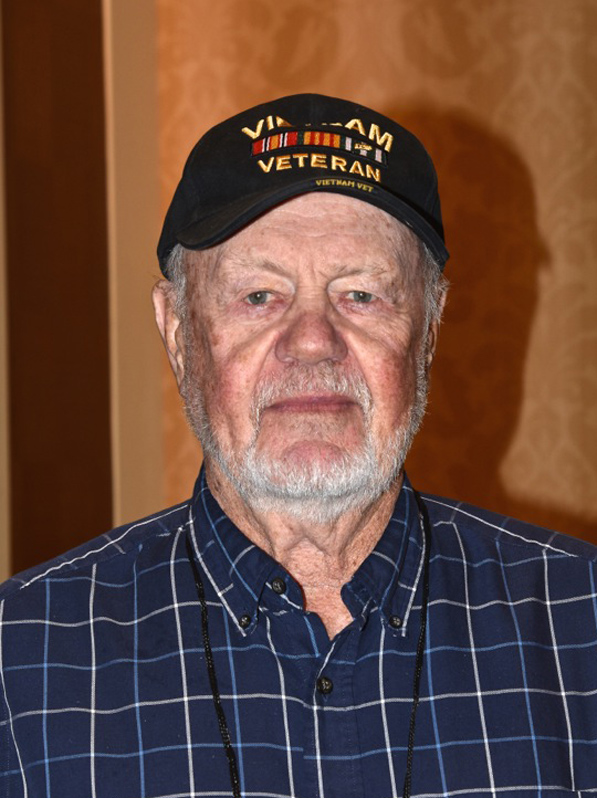
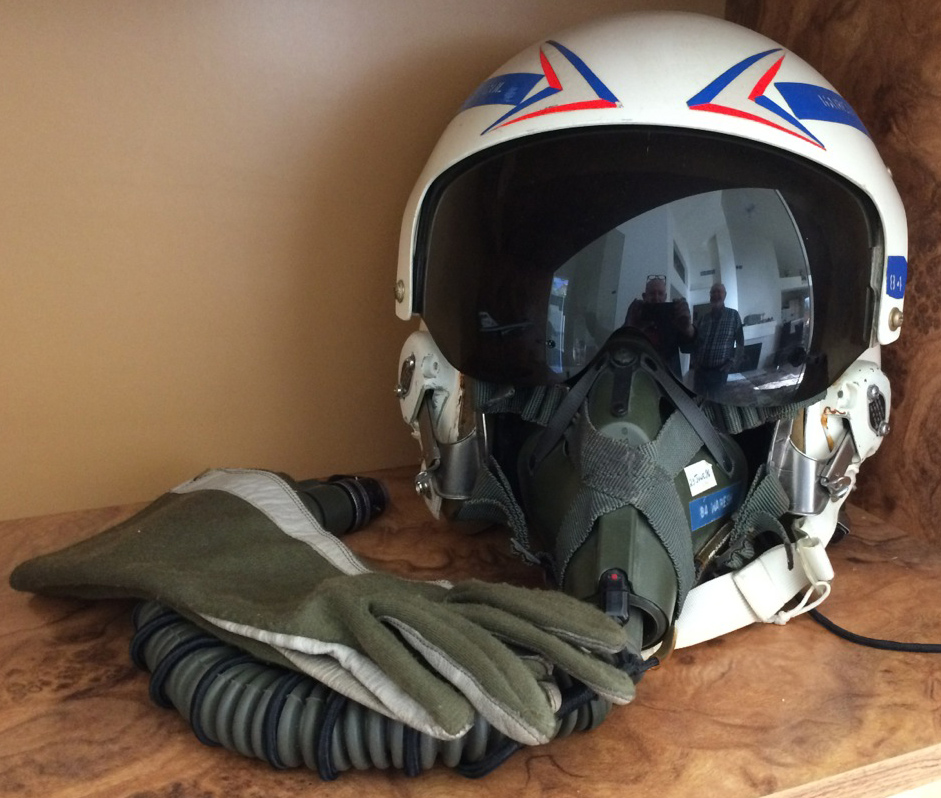
LTC Waresh’s helmet, oxygen mast and gloves used when flying fighter jets.
Leave A Comment